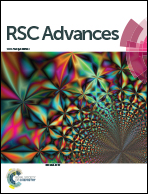Cadmium sulphide quantum dots with tunable electronic properties by bacterial precipitation†
Abstract
We present a new method to fabricate semiconducting, transition metal nanoparticles (NPs) with tunable bandgap energies using engineered Escherichia coli. These bacteria overexpress the Treponema denticola cysteine desulfhydrase gene to facilitate precipitation of cadmium sulphide (CdS) NPs. Analysis with transmission electron microscopy, X-ray diffraction, and X-ray photoelectron spectroscopy reveal that the bacterially precipitated NPs are agglomerates of mostly quantum dots, with diameters that can range from 3 to 15 nm, embedded in a carbon-rich matrix. Additionally, conditions for bacterial CdS precipitation can be tuned to produce NPs with bandgap energies that range from quantum-confined to bulk CdS. Furthermore, inducing precipitation at different stages of bacterial growth allows for control over whether the precipitation occurs intra- or extracellularly. This control can be critically important in utilizing bacterial precipitation for the environmentally-friendly fabrication of functional, electronic and catalytic materials. Notably, the measured photoelectrochemical current generated by these NPs is comparable to values reported in the literature and higher than that of synthesized chemical bath deposited CdS NPs. This suggests that bacterially precipitated CdS NPs have potential for applications ranging from photovoltaics to photocatalysis in hydrogen evolution.


 Please wait while we load your content...
Please wait while we load your content...